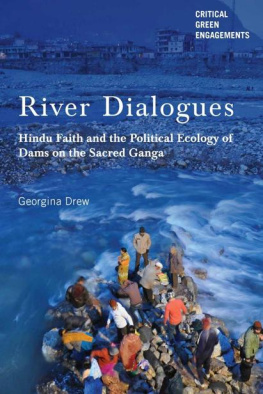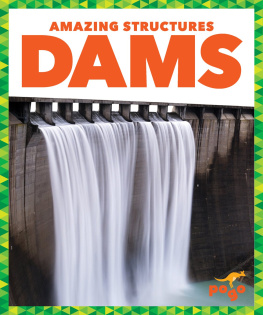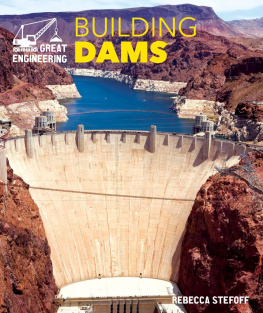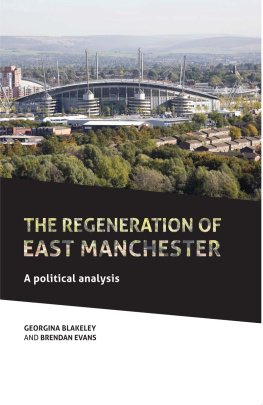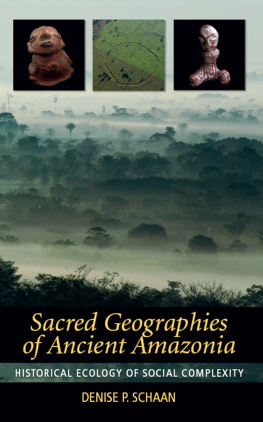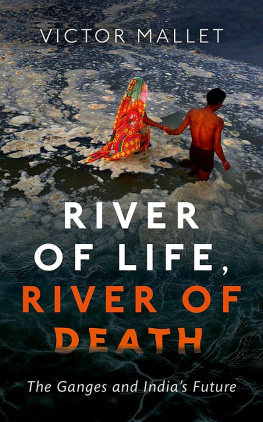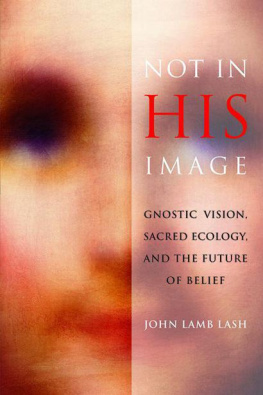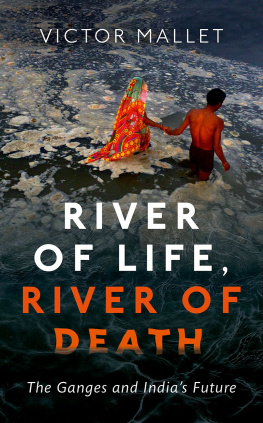Georgina Drew - River Dialogues: Hindu Faith and the Political Ecology of Dams on the Sacred Ganga
Here you can read online Georgina Drew - River Dialogues: Hindu Faith and the Political Ecology of Dams on the Sacred Ganga full text of the book (entire story) in english for free. Download pdf and epub, get meaning, cover and reviews about this ebook. year: 2017, publisher: University of Arizona Press, genre: Politics. Description of the work, (preface) as well as reviews are available. Best literature library LitArk.com created for fans of good reading and offers a wide selection of genres:
Romance novel
Science fiction
Adventure
Detective
Science
History
Home and family
Prose
Art
Politics
Computer
Non-fiction
Religion
Business
Children
Humor
Choose a favorite category and find really read worthwhile books. Enjoy immersion in the world of imagination, feel the emotions of the characters or learn something new for yourself, make an fascinating discovery.
- Book:River Dialogues: Hindu Faith and the Political Ecology of Dams on the Sacred Ganga
- Author:
- Publisher:University of Arizona Press
- Genre:
- Year:2017
- Rating:3 / 5
- Favourites:Add to favourites
- Your mark:
- 60
- 1
- 2
- 3
- 4
- 5
River Dialogues: Hindu Faith and the Political Ecology of Dams on the Sacred Ganga: summary, description and annotation
We offer to read an annotation, description, summary or preface (depends on what the author of the book "River Dialogues: Hindu Faith and the Political Ecology of Dams on the Sacred Ganga" wrote himself). If you haven't found the necessary information about the book — write in the comments, we will try to find it.
Georgina Drew: author's other books
Who wrote River Dialogues: Hindu Faith and the Political Ecology of Dams on the Sacred Ganga? Find out the surname, the name of the author of the book and a list of all author's works by series.
River Dialogues: Hindu Faith and the Political Ecology of Dams on the Sacred Ganga — read online for free the complete book (whole text) full work
Below is the text of the book, divided by pages. System saving the place of the last page read, allows you to conveniently read the book "River Dialogues: Hindu Faith and the Political Ecology of Dams on the Sacred Ganga" online for free, without having to search again every time where you left off. Put a bookmark, and you can go to the page where you finished reading at any time.
Font size:
Interval:
Bookmark:
CRITICAL GREEN ENGAGEMENTS
Investigating the Green Economy and Its Alternatives
Jim Igoe, Molly Doane, Dan Brockington, Tracey Heatherington, Bram Bscher, and Melissa Checker
SERIES EDITORS
Hindu Faith and the Political Ecology of Dams on the Sacred Ganga
GEORGINA DREW

TUCSON
The University of Arizona Press
www.uapress.arizona.edu
2017 by The Arizona Board of Regents
All rights reserved. Published 2017
Printed in the United States of America
22 21 20 19 18 17 6 5 4 3 2 1
ISBN-13: 978-0-8165-3510-1 (cloth)
Cover design by Leigh McDonald
Cover photograph by Georgina Drew
Portions of were originally published as Our Bones Are Made of Iron: The Political Ecology of Garhwali Womens Activism, The Australian Journal of Anthropology 25 (2014): 287303. 2014 Australian Anthropological Society. Used with permission by John Wiley and Sons.
Unless otherwise noted, all photographs are by the author.
Publication of this book is made possible in part by the proceeds of a permanent endowment created with the assistance of a Challenge Grant from the National Endowment for the Humanities, a federal agency.
Library of Congress Cataloging-in-Publication Data are available from the Library of Congress.
 This paper meets the requirements of ANSI/NISO Z39.48-1992 (Permanence of Paper).
This paper meets the requirements of ANSI/NISO Z39.48-1992 (Permanence of Paper).
ISBN-13: 978-0-8165-3627-6 (electronic)
FIGURES
TABLE
Let the Ganga flow free!
Let the Ganga remain pure!
Ganga ko aviral behne do!
Ganga ko nirmal rehne do!
DAM OPPOSITION CHANT
GANGAS FLOW THROUGH INDIA

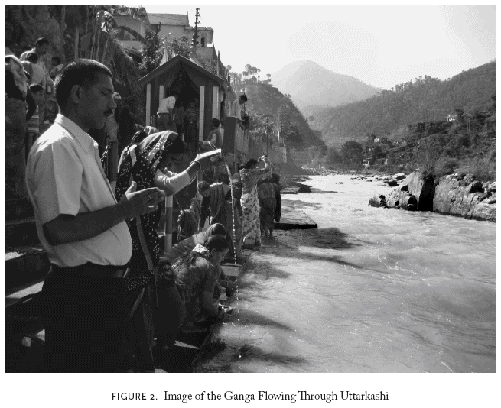
Development Encounters in Religious Landscapes
THIS BOOK EXPLORES CONFLICT over development and conservation along a Himalayan stretch of the River Ganga (also known as the Ganges) in Indias Uttarakhand State. It focuses on competing discourses about change, including the transformations brought on by hydroelectric development, along a water body that is revered by Hindus as a living goddess whose unfettered flow is capable of physically and spiritually purifying devotees. I emphasize the competing values asserted by people from a range of socioeconomic backgrounds over how the Gangas freely flowing waters should be used and protected. These different perceptions are part of the cultural politics that fueled the controversy over dam building on the Ganga, and they are important to the contestations that arose when the region was eventually declared an Ecologically Sensitive Zone. The tensions that emerged over the policy change are best understood, I argue, by combining the lens of cultural politics with political ecology. I explain these links in the introduction and throughout the book. Here, I pause to situate the growth of my interest in these issues and explain the ways in which I came to study them.
My engagement in the topics that inspire this book emerged in a roundabout way. The first time I saw an image of the River Ganga I was an undergraduate student at a small liberal arts college in California in the late 1990s. I recall being seated in a Cultural Anthropology course that was about to start when I turned to a page in my textbook and saw a photograph that visually captured a momentof Hindu reverence for the river and its associated goddess. The photo, which showed people with hands folded in moments of prayer as they faced toward the Ganga, was most likely taken from the rivers banks in Varanasi, India. This is arguably one of the most iconic locations for the Gangas worship due to the continuity of rituals for the living and the dead that span over two millennia in the oldest of Indias thriving cities. I remember feeling curiosity when confronted with a scene so different from anything I had known growing up on the west coast of the United States. It would perhaps make for a good story if I said that I felt something more, that a part of my being stirred at the sight of those prayerful poses. That would not be the truth; instead, I absorbed the image and continued my study of different religious practices from around the world before the instructor walked in and class began.
I recalled this memory when I encountered the river several years later in 2004. I first saw and touched its waters at a point where the river emerges from the Himalaya in a city known as Rishikesh. Experiencing the river in person was completely different from seeing a photo. The Ganga was wide and powerful as it flowed through a riverbed bordered on all sides by ashrams (centers of religious or spiritual retreat). Devotees of Indian and foreign origin emerged throughout the day to touch the waters and to swim playfully in parts of the river where the current was not too swift. At twilight, people gathered to sing devotional songs alongside the Gangas banks in evening fire ceremonies referred to as aarti. The embodied experience of being alongside the river and of seeing the emotional fervor with which it is celebrated was beyond anything I imagined. In a world where water resources are so easily taken for granted, the reverence I witnessed for the Ganga stood out as a welcome exception.
As 2004 wore on, I found myself compelled to return to the river. I traveled to Varanasi and saw scenes reminiscent of that textbook photo. I also returned several times to Rishikesh. It was enthralling to watch people approach the Ganga time and again with their prayers and their faith in the rivers powers of inner and outer purification (to be explained more in subsequent chapters). At the same time, I was also increasingly alarmed by reports in the news that the Gangas headwaters were being subject to a series of hydroelectric development projects. These projects were located near to the upstream glaciers that feed one of the Gangas first tributaries, labeled on maps as the Bhagirathi (and sometimes the Bhagirathi Ganga). The newspapers and online media outlets noted that these glaciers were receding and that the dams were likely shortsighted efforts that would be rendered obsolete if the glaciers disappeared. In my navet,I struggled to understand why the government would approve projects on the last freely flowing section of a sacred Hindu river, especially when the ecological context seemed so fragile.
Toward the end of 2004, I traveled to the Gangas first tributary to see for myself the impact of the ongoing hydroelectric development projects. On my way up the mountains above Rishikesh, in the region of Garhwal, I passed a colossal dam in its final stages of completion. The rock-and-earth fill construction stood out as a somber gray pyramid stuck in the middle of a valley between two mountainsides, near a town called Tehri. The dam would eventually submerge over a hundred villages and displace thousands of people.
The Tehri dam was not, however, my point of focus. Although it would become important to my understanding of the politics of hydroelectricity along the Ganga, I was initially more interested in understanding the impact of three new projects that were planned for construction much farther upstream. I continued onward, eventually traveling to a prominent point of worship to the goddess Ganga at a high-altitude temple town known as Gangotri. This location is above where the three newest dams were targeted for implementation; however, since those projects were not yet in visible stages of construction, the trip to Gangotri allowed me to see one of the more auspicious pilgrimage destinations for Ganga devotees. Once there, I traveled 22 kilometers (15 miles) by foot to the receding terminus point for the Gangotri glacier. By the time I reached the terminus pointan outcropping of ice called Gaumukhmy head spun from the increase in altitude and exposure to the sun on the long hike over rocky terrain. Bits of greenish-blue ice shone from under the gray, soot-looking debris covering the glacier. This lent an air of fragility to an otherwise massive and commanding body of ice that stretches far up into the mountains. Along the way, in Gangotri and on the trails, I asked those I met about the three impending dams planned for construction downstream. Only one person offered a strong opinion: a Hindi swami, who dedicated a large portion of his life to photographing changing Himalayan ecologies, lamented that the dams would not make a difference; Ganga was already finished (
Font size:
Interval:
Bookmark:
Similar books «River Dialogues: Hindu Faith and the Political Ecology of Dams on the Sacred Ganga»
Look at similar books to River Dialogues: Hindu Faith and the Political Ecology of Dams on the Sacred Ganga. We have selected literature similar in name and meaning in the hope of providing readers with more options to find new, interesting, not yet read works.
Discussion, reviews of the book River Dialogues: Hindu Faith and the Political Ecology of Dams on the Sacred Ganga and just readers' own opinions. Leave your comments, write what you think about the work, its meaning or the main characters. Specify what exactly you liked and what you didn't like, and why you think so.

